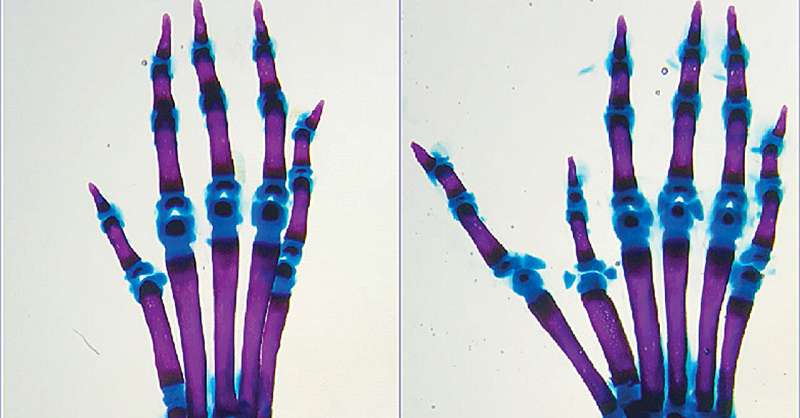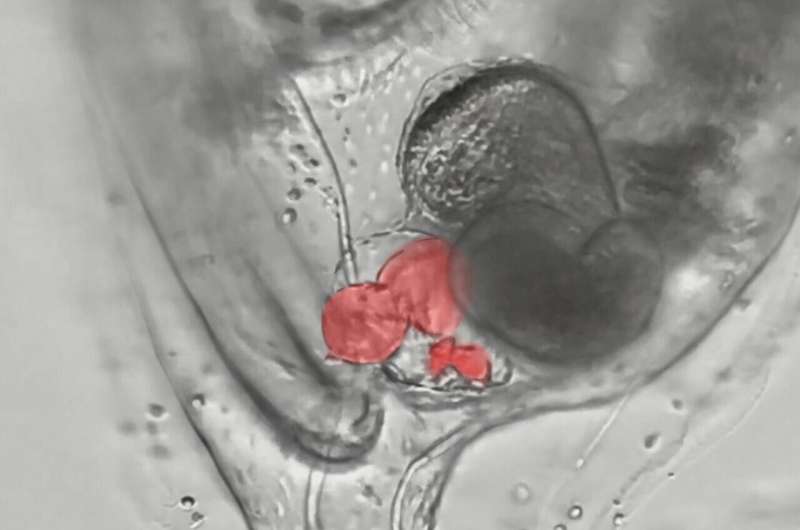This article has been reviewed according to Science X's editorial process and policies. Editors have highlighted the following attributes while ensuring the content's credibility:
fact-checked
trusted source
proofread
Extra fingers and hearts: Pinpointing changes to our genetic instructions that disrupt development

Our genomes provide the instructions for proper growth and development. Millions of genomic switches, known as enhancers, control the location and timing of gene expression, which in turn ensures the correct proteins are made in the right cells at the right time throughout our lives.
New research from University of California San Diego Assistant Professor Emma Farley's lab shows how we can now predict which single base-pair changes to the DNA within our genomes will alter these instructions and disrupt development, causing extra digits and hearts.
We now have genome sequences for over half a million people and counting. These genomes hold the key to how each of us comes to be and the promise of attaining precision medicine tailored to an individual's own genetic makeup. Yet we cannot take full advantage of these datasets since we don't understand a critical aspect of the genome: enhancers, which act as switches to control when and where our genes are expressed as proteins. Most genetic variants or mutations that cause disease lie within these enhancers.
A central challenge has been to determine which sequence changes within enhancers matter and which do not. Thus far, pinpointing such causal enhancer variants has been akin to searching for a needle in a haystack.
Publishing in the journal Nature, the Farley lab has addressed this challenge by achieving the ability to predict which changes to enhancers would cause changes in gene expression across thousands of enhancers and cell types. This ability to predict causal enhancer variants is rooted in a deep understanding of how enhancers function.
The researchers showed that enhancers activate gene expression by binding proteins known as transcription factors very weakly. Adhering to this rule ensures enhancers activate gene expression, and thus protein production, at the right level, place and time.
The Farley lab found that single-letter changes to our genome that 'strengthen' the interaction of an enhancer with a transcription factor cause enhancers to switch on gene expression inappropriately and make proteins at the wrong level, time and/or place. Therefore, these single-letter changes to the enhancer DNA within our genome have dramatic effects on the genetic instructions, leading to extra fingers in mice and humans.
The Farley lab identified three human families in which such mutations cause extra fingers and was able to predict which mutations would lead to even more fingers and more severe limb defects. Their ability to predict which enhancer variants will alter genomic instructions is not limited to limbs and generalizes to thousands of enhancers across cell types and species.
In a complementary study published in Developmental Cell, the Farley lab showed that within marine animals known as sea squirts, single-letter changes that make heart enhancers stronger led to the development of a second beating heart.

Pinpointing enhancer variants that alter the instructions for development encoded in a genome is key for seizing the full potential of genomic data for improving human health and obtaining the goals of precision medicine.
Across thousands of enhancers, the Farley lab found that searching for DNA base-pair changes that make enhancers stronger enabled (up to) a seven-fold increase in their ability to find causal enhancer variants.
"Our study illustrates a key vulnerability in our genomes: single base-pair changes that make transcription factors bind to an enhancer even slightly stronger can cause developmental defects," said Farley, a faculty member in the Departments of Medicine (School of Medicine) and Molecular Biology (School of Biological Sciences).
"Taking advantage of this knowledge will allow us to better predict which enhancer variants underlie disease in order to harness the full potential of our genomes for better human health."
For the Nature paper, the first authors of this work are two UC San Diego graduate students, Fabian Lim (Biological Sciences) and Joe Solvason (Bioinformatics and Systems Biology), and postdoctoral scholar Genevieve Ryan.
The Developmental Cell paper was authored by postdoc Granton Jindal, graduate students Alexis Bantle (Biological Sciences) and Joe Solvason (Bioinformatics and Systems Biology), Jessica Grudzien, Agnieszka D'Antonio-Chronowska, Fabian Lim, Sophia Le, Benjamin Song, Michelle Ragsac, Adam Klie, Reid Larsen Kelly Frazer and Emma Farley.
More information: Fabian Lim et al, Affinity-optimizing enhancer variants disrupt development, Nature (2024). DOI: 10.1038/s41586-023-06922-8
Granton A. Jindal et al, Single-nucleotide variants within heart enhancers increase binding affinity and disrupt heart development, Developmental Cell (2023). DOI: 10.1016/j.devcel.2023.09.005


















